Tack & Farm
Our Tack & Farm section features an Apparel section to find both practical and fashionable riding attire. If you ride English & Western or Race, many sources are available in the Tack section.
Building a barn? Need an architect for your equine dream home? Find one in Barns & Stalls.
Have a hungry horse? Of course you do! Find a place to buy your feed and tuck your horse in at night in the Bedding & Feed section. Looking for a place to keep your horse? You can find it in the Horse Boarding section. Keep your horse happy and beautiful with resources in our Grooming section.
Traveling? Find a Shipping company or Horse Sitting service if your horse is staying home!
Running and maintaining a farm or stable is a continuous effort, and to help find products or tools you need, please see our Equipment, Fencing and Management Tools sections.
Seeking Services? Find financial and tax expertise in our Accounting section. Companies who will help protect your investment are found in the Insurance section. For those who want legal advice about purchasing, liability, and other issues, please look at the Equine Law section to find an expert. Build and promote your business with teams from Marketing / Videography / Web Design.
Do we need to add more? Please use the useful feedback link and let us know!
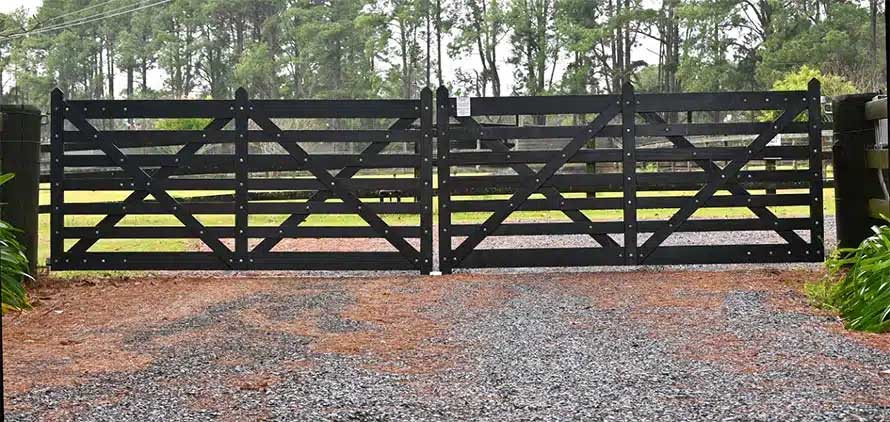
by Nikki Alvin-Smith for Horizon Structures
The effort involved in figuring out the right dimensions for the myriad of gates and entranceways needed at a horse farm and their careful installation is well worth the investment.
With this safety and security size guide, the effort involved in figuring out the right dimensions for the myriad of barn doors, gates and entranceways needed at a horse farm and their careful installation is well worth the investment.
The Main Gate(s)
Entranceways to the property that are too narrow will result in persistent issues with damage from users. Especially the heavy equipment that will commonly access the driveway to a horse property such as tractor-trailers full of hay or shavings, large horse trailers or trucks, tractors and various farm equipment.
The use of gates at the main entrance is a good idea as these can be securely closed when necessary to afford better protection and safety for both horses and humans residing on the farm. Houdini horses, neighborhood dogs on the loose, folks with nefarious intent to steal, wandering passers-by who choose not to pass by at all but come up the driveway to investigate, photo and even feed horses pastured alongside the driveway, can all be foiled by the use of closed gates.
Electrical management of the open/close necessity of these gates is commonly employed to avoid the need for frequent hopping in and out of vehicles to manage the task manually. Consider the topography of the ground (it needs to be level), and the fact that heavier gates will require back-up support on each side with possibly a second post.
Regardless of due care and attention by drivers, damage to the gates may occur. The risk of damage may be minimized by placing the gates well back from the edge of the driveway, perhaps protected by shrubbery planted on each side to serve as a soft barrier or large rocks placed just to the inside line.
Bear in mind that fancy, stone encased pillars look beautiful but if they take a hit these can be expensive to repair.
Standard driveway widths for a residential property are between 9 to 12 feet in the U.S.A., but for a horse or farm property it is wise to go much larger. A 24-foot width will serve well if you have the room. The more acute the turn off the road and the narrower or busier the road from which the vehicles must enter, the wider the gate width will ideally be built.
If you set the gate posts further to the inside of the property there will be less chance for damage as the turn into the entrance can be constructed as a softer curve than a gate post installed on the property line.
Wherever a gate is placed on a curve, extra distance from the edge of the driveway to the gate post/gate should be added. An additional 2 feet on each side of the driveway is a good average to work from but also consider the length of the vehicles and their likely turning radius.
Distance from the ground surface for gates should be between 3 to 6 inches, with much larger distances allowed if the property is situated in a snow region.
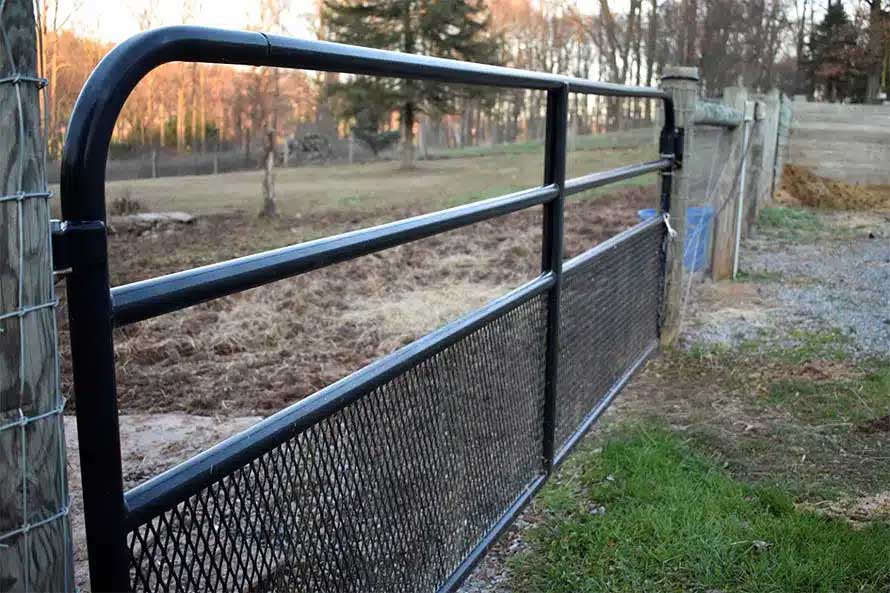
Design of the gates may include panels or bars, or mesh to deter dogs and smaller mammals. Attention should be paid to the distance between panels or bars in regard to safety for horse and human. Some building codes require certain parameters (less than 5” apart for bars to avoid young children trapping their heads between them when playing).
Cattle grids at entranceways to horse properties are a recipe for disaster for obvious reasons and should be avoided.
One Gate or Two
Obviously the wider the gate the heavier it will be to open and close. Wood gates are exceptionally heavy and can be unwieldy to manage, while light aluminum gates with large panels can be difficult to work with during high winds.
Farm style tube and panel gates should be effectively hinged for safety and to avoid simply being lifted off their hinges by trespassers. Iron, PVC or custom designed gates will all have different hinge requirements. When open, the gates should have a stand on which to rest the weight, especially if they are to be left open for any length of time to prevent them from ‘dropping’ or swinging back and forth during windy weather.
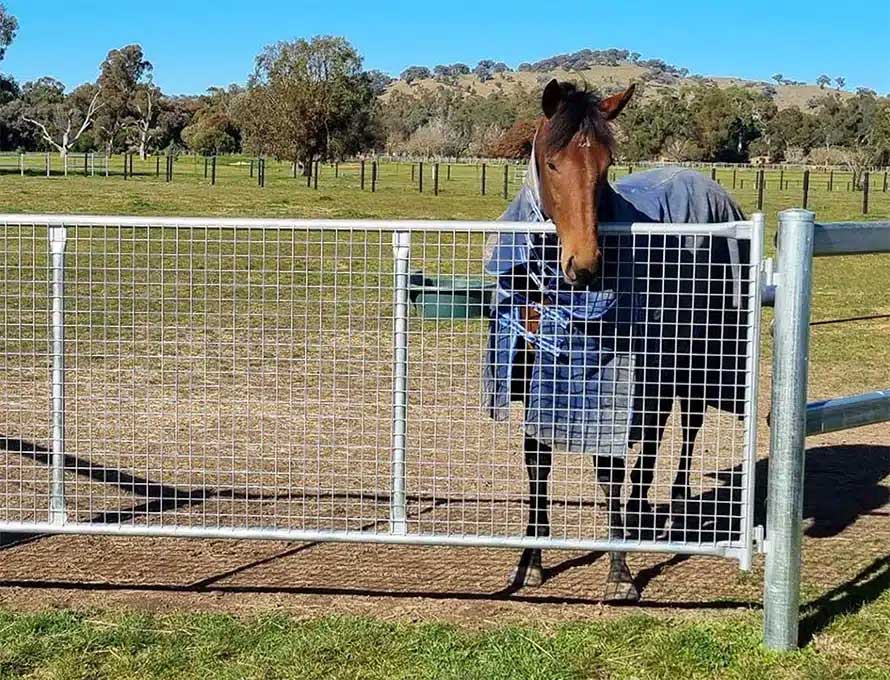
Sidebar: For tube/horse panel gate installation in paddocks/pastures and entranceways to the property, consider placing the top hinge facing down and the bottom hinge facing upward. This will also stop horses inadvertently (or advertently) lifting the gate off its hinges trying to graze beneath it. Though if a horse’s leg becomes trapped beneath it due to rolling too close to the gate it also means the gate will not pop off when the horse kicks or struggles to free himself.
Barn Doors
The main entry doors to the barn or other storage structures, need to be large enough to accommodate the use of ATVs, UTVs, and compact tractors.
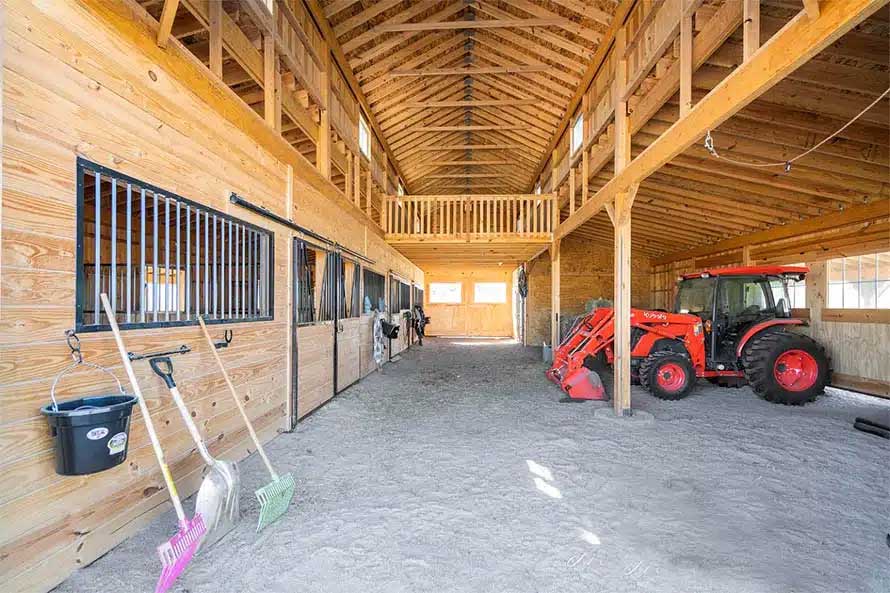
Center aisles or side aisles should be designed to be wide enough to make driving through the building easy to accomplish without hitting tack boxes, saddle racks or other barn accoutrements that may be placed on or against the front stall walls. If the barn design allows horses to have access over stall doors or front walls of the stalls to the aisle, the width of the ‘driving’ lane should be wide enough to ensure they cannot reach the equipment.
Standard barn door sizes and widths in center aisle barns range between 10 and 14 feet, but wider aisles should be incorporated in the design of high traffic barns with doors at the gable ends to match.
Sliding, swinging or electric overhead doors are all options for entry doors. The latter being useful in snow regions, although be aware metal doors can freeze to the ground during periods of cold weather. However, a manual override is a necessity in case of power outages for electrical doors.
Doors should generally be placed at the gable ends of the building to avoid snow building up in front of them making the building interior inaccessible, and to avoid puddling from rain shed off the roof. The installation of gutters is a great idea to remove excess water from above entryways.
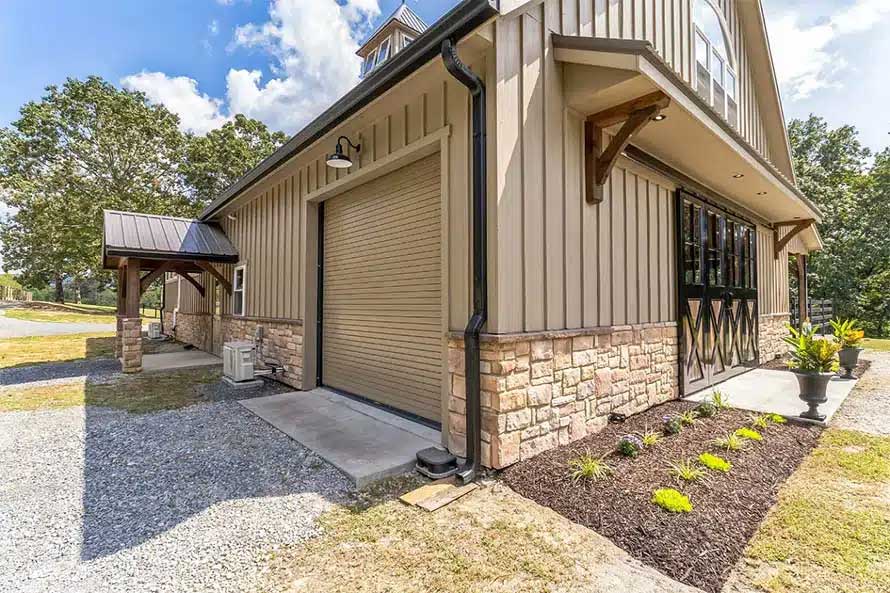
A smaller ‘person’ door or ‘horse’ door (4 foot or wider) can be included to one side of the gable end in larger barn builds, to avoid the necessity of opening big doors in adverse weather.
All doors should be properly locked back or secured in both open and closed positions to prevent them from moving/rattling or lifting off their tracks during high winds.
Stall Doors
A stall door is generally constructed with a standard width of 4 feet. However, for larger breeds of horses such as draft horses or warmbloods, an additional 6-12 inches can be added for ease of use.
When handling horses the safety-first approaches of avoiding swing stable doors and constructing the stall doorways wide enough for both horse and handler to navigate the gap easily without crowding each other should be employed.
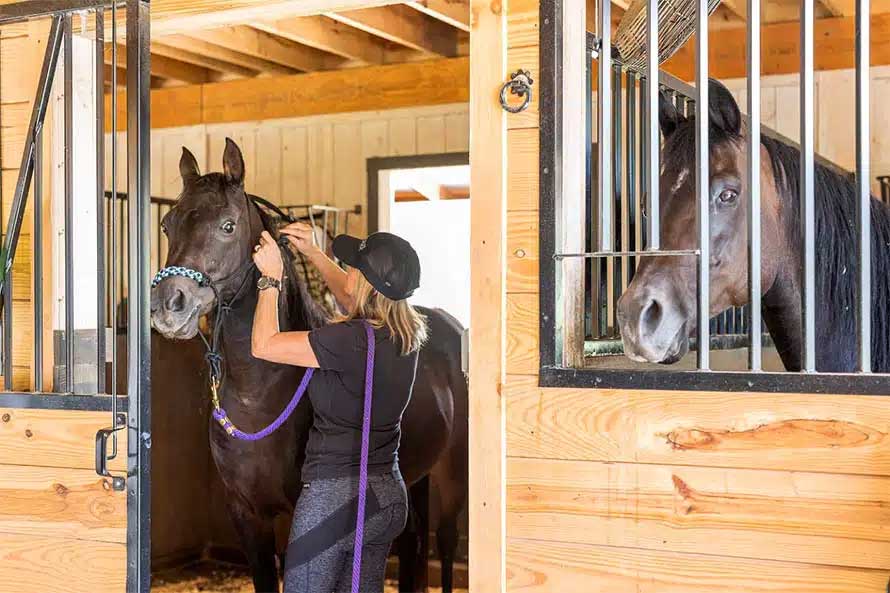
The myriad of stall door designs available are extensive but regardless of which you choose always consider safety first and ensure the door hardware is easy to operate for humans and hard to navigate for horses.
Where stall doors are not solid and grills are incorporated, a 4” gap is standard in horse stable door grills, though even this distance can be hazardous to a rearing foal.
Paddocks and Pastures
For paddocks and pastures the gate width is also of great importance. There is nothing more annoying than installing a horse friendly turnout gate of 8 to 10 feet and then figuring out you can’t fit your bushhog and tractor for a summer ‘deworm control’ mow or a tidy up in Fall.
Large pastures may even at some point be up for haymaking, where equipment that today’s farmers utilize can be 14 feet wide or more.
Read more: Sizing Up Your Horse Barn and Farm Entranceways for Safety and Security
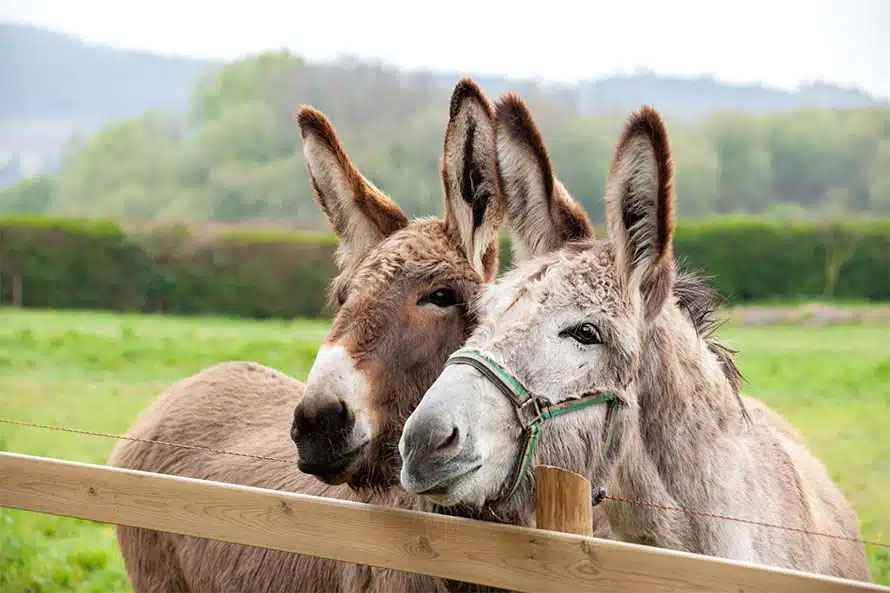
by Nikki Alvin-Smith for Horizon Structures
Donkeys of course are not horses, their needs for care and shelter, feed and forage, and general health care are a bit different to their larger and more energetic cousins.
When I began my equestrian career eons ago as a kid, my first Equus was a baby donkey called Sage. Along with his half-sister Cleo, they were purchased by Mom and Dad from a donkey breeding stud in the heart of the Gloucestershire countryside. Not that I was very happy about that at the time as I was hoping for a pony, but a horse is a horse of course. Well, kind of – so my late kid brother and I adjusted our wish list and set about training the wee beasties. At first with walks on bridle trails through the woods on halters, and later under saddle using the smallest tack we could find, racing saddles.
A donkey, as my farm neighbor (an equestrienne in the showjumping world of some repute) had told my neophyte pet-owning parents, was the perfect ‘starter’ horse for a child. And looking back I have to agree. Being kids, we treated Sage and Cleo just as we would a horse. We rode them in local gymkhanas where they would outshine ponies in the agility class. We would give donkey rides at local village fêtes among the tombolas, white elephant stalls and cake stands. We even participated in Palm Sunday processions some years, taking them inside the tiny village church much to the joy of children participating in the service. In fact, we rode them around the country lanes so much, we had to have them shod. The farrier was not happy about that job, and he dreaded seeing us show up at his forge.
After 38 years and 34 years respectively, Sage and Cleo, departed over the rainbow bridge. Sadly, my donkey Sage lost his life in a stable fire at my parents’ property. Though of course I headed out of their daily lives long before that, their companionship was a great comfort to my parents as they also aged up in years.
As you may imagine, donkeys and all the delights they provide are very close to this advanced dressage rider’s heart. We all start somewhere, and keeping donkeys taught me self-discipline, putting animal’s needs before my own, how to ride and stay safe riding on the roads, and generally gave my brother Curtis and I endless hours of fun.
How do you care for donkeys? Donkeys of course are not horses. And how to care for donkeys shelter, feed and forage, and general health care are a bit different to their larger and more energetic cousins. If you are setting out on the donkey owning adventure, there are a few caveats to know and a well-trodden path to follow to help ensure the wee beasties thrive under your care.
Stabling and Turn-Out
Donkeys are notoriously good at keeping unwanted critters out of their territory and are often kept as a deterrent to chase pesky loose dogs in the neighborhood, and even keep coyotes or other wildlife out of livestock enclosures. Alpacas, sheep, goats, poultry etc. are all vulnerable to attack by predators, and the donkey with his keen territorial sense will usually attack any invader.
Turnout is good for all Equus as it keeps their joints and digestive system moving and their minds refreshed and happy, but smaller species in the genus like donkeys, including the miniature variety, are prone to laminitis.
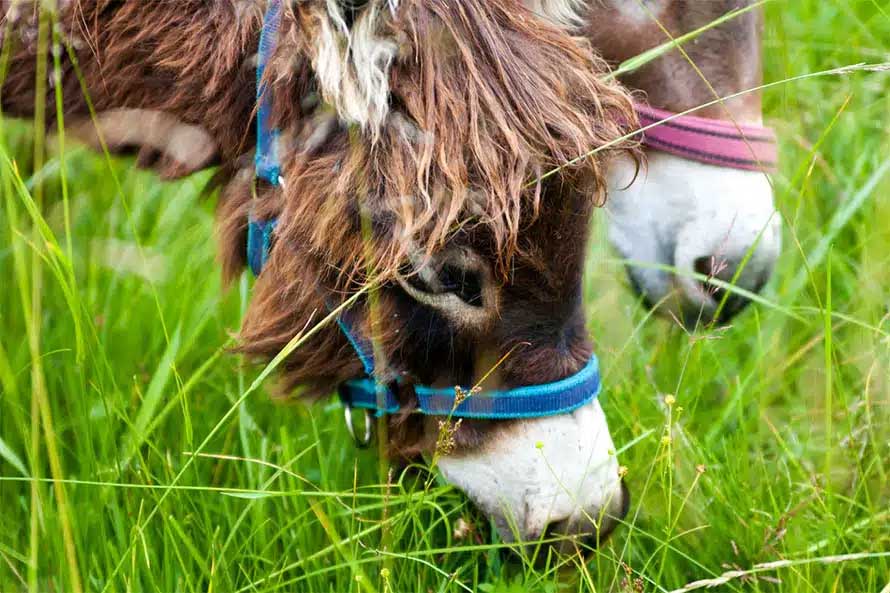
Keeping the grass from being overgrazed and free of worms is important. Manure removal from paddocks, harrowing the pastures in hot weather for best breakdown of worm larvae, deworming protocols for the donkey including fecal worm counts before treatment, are all good methods to incorporate in caring for donkeys.
Sidebar: Donkeys are the preferred host for lungworm. Dictyocaulus arnfieldi is a nematode that all donkeys should be treated for to avoid contamination of the pasture.
To mitigate the risk of laminitis, it is wise not to overgrain or overfeed donkeys. This includes keeping the grass long enough not to become oversweet (5-6 inches tall is optimal), keeping donkeys off pasture after a heavy frost when sugars are highest in the grass, and ensuring that the hay or forage provided is low in sugar.
Fences should be sturdy and secure to keep donkeys in their safe space. While a donkey does not require the height of fence a 16hh horse may need to keep it from jumping out (5’ is the standard), any fencing should always be installed with a view to future use. Because as is often the case including my own, in family life ponies follow donkeys and horses follow ponies. Barbed wire is not suitable for use around any Equus.
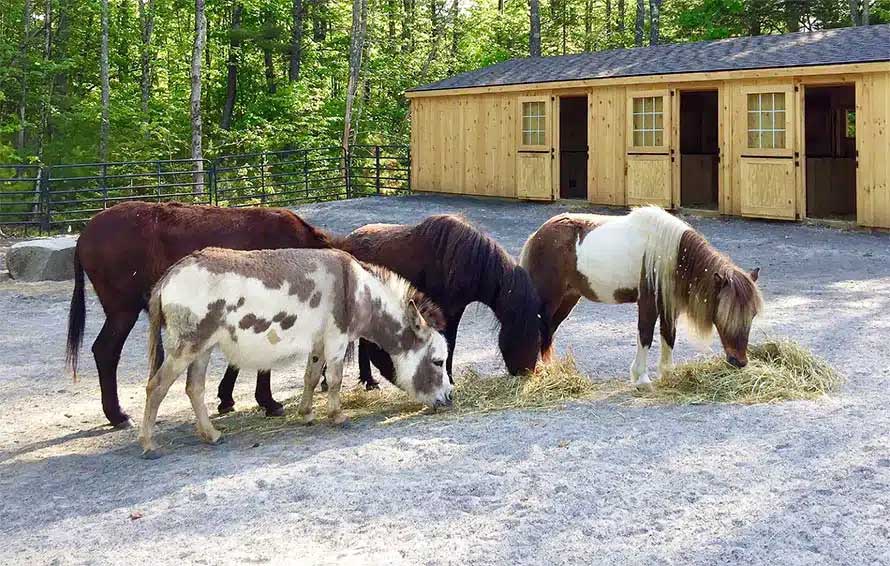
All animals should be provided with some form of shelter from wind, rain, snow and most particularly sun. As donkeys are smaller than horses and have a higher surface area-to-volume ratio than their counterparts, donkeys will feel the negative effects of extreme heat and cold faster than horses.
Bearing this in mind, the donkey is generally quite happy to share stable space with his compatriot herd members. A large interior barn space, or even a relatively small 12’ x 12’ stall can suffice for a few donkeys to share, as long as their grain rations are provided individually, and each receives its fair share.
Blanketing donkeys is not usually necessary unless they are very young, very old or ill, the provision of a run-in shed, or some form of in/out shelter is necessary.
Stable/stall doors of the Dutch variety installed on the exterior of the barn can facilitate the donkey’s freedom to choose to be inside or outside.
Dutch doors or stable/stall doors can be built to include three rather than the standard two split style design. This allows the stall door to be low enough to offer a room with a ‘boredom relieving’ view for the animal, while still allowing the stable’s use by horses if the need arises in the future.
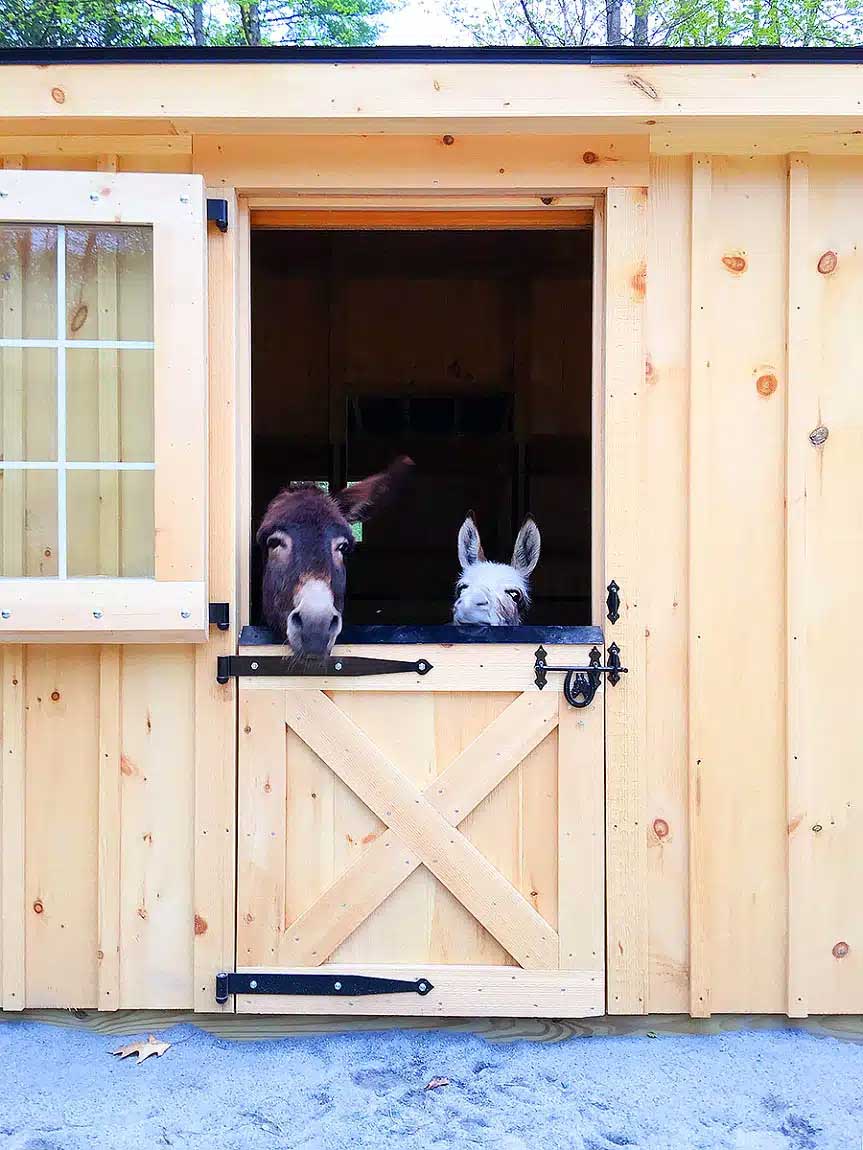
Bedding your donkey on pelleted bedding or pine shavings (ensure no walnut or cherry wood is present as these woods will founder an animal) is a good idea versus straw or hay. Hay will encourage lice and fleas and is heavy and arduous to keep clean. Hay is not a good bedding material for Equus. Straw (only wheat or oat straw should be used, barley is not suitable due to its barbs), is often just a feast for the wee beast who will bloat up quickly by ingesting it.
To cut down on bedding needs and to provide comfort for the animal when laying down, rubber mats installed over a compacted stone dust stall floor or concrete floor is a good idea. Dirt floors will quickly disintegrate into muddy pits and cratered surfaces where urine and manure are consistently removed during the daily mucking out process especially where geldings will use the same spot to relieve themselves.
Give Your Donkey A Job
Donkeys, just like many domesticated animals, enjoy attention and interaction with humans. Donkeys make great service animals and companions.
However, donkeys, just like horses, do require training and establishing some basic ground rules is an essential part of an owner’s responsibility. A donkey should pick up his feet for the farrier for trimming (every 6-8 weeks is usually needed) without fuss. He should accept a halter and rope and be complaint to lead forward, stop and back up. Ideally, he would also be trained to walk onto a trailer for transport.
A donkey that works in harness in a small cart or is ridden by smaller sized equestrians (a rider will ideally only weigh up to 12% of the animal’s weight), will need appropriate training so that he understands his job. Just like horses donkeys will bolt off if frightened, kick, rear and generally act up if they are not properly trained. If you do not have the necessary experience in this training regard it is well worth investing in some professional help to set you on the right track.
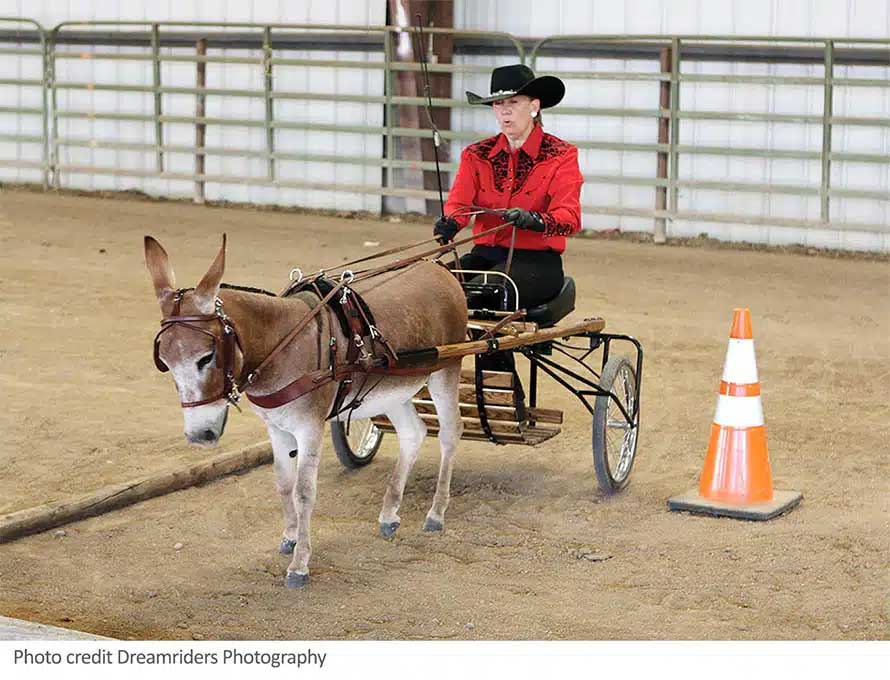
Giving your donkey good basic training is a gift he will be blessed with all his life, and he will always be welcomed in the future as a new acquisition elsewhere should your circumstances change over his long lifetime and a requirement to sell or rehome him become necessary.
Bear in mind that donkeys are herd animals and do best with some form of animal companionship. It does not have to be another Equus, a goat, an alpaca, a few sheep or a cow will suffice.
Farrier and Veterinary Care
Just like horses, donkeys do require regular farrier and veterinary care. Set yourself up for success by engaging their services from the outset of your donkey ownership. Routine vaccinations against prevalent diseases such as rabies, equine influenza, encephalitis, tetanus and several more are necessary depending on where you live.
Take Home Message
So, are donkeys easy to care for? Donkey ownership can be very rewarding and is relatively easy to navigate. Watching the animals interact, hearing their noisy welcoming bray as you appear with a flake of hay or engaging them in work and play is something the whole family can enjoy.
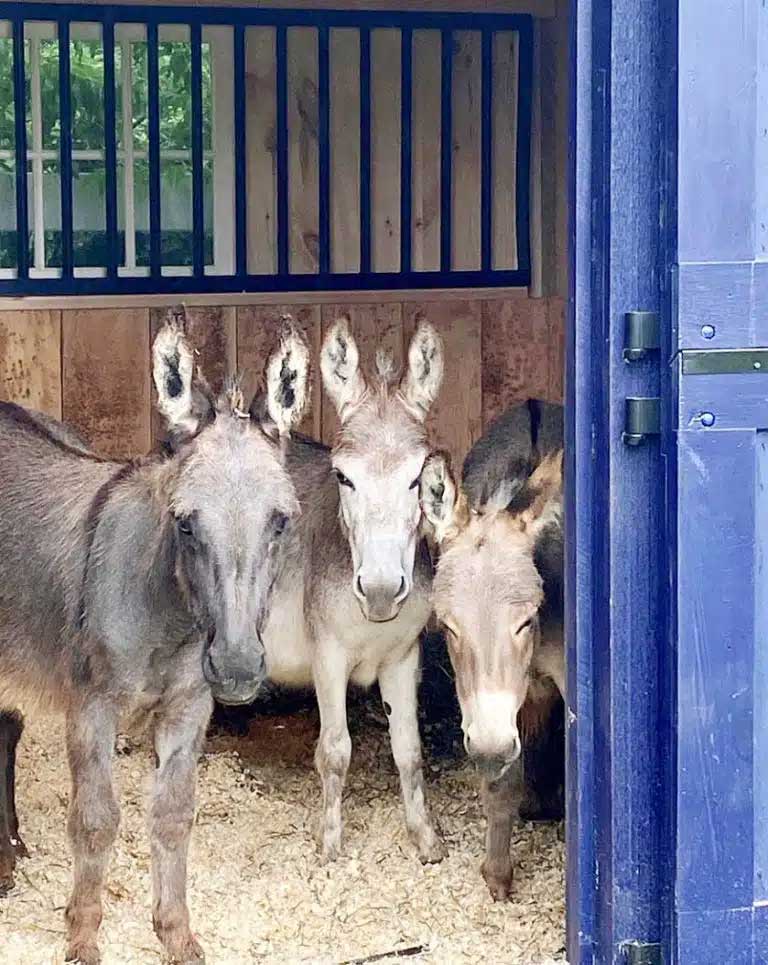
Why not give it a go? There are many donkeys out there seeking a home.
This article originally appeared on Horizon Structures and is published here with permission.
You can find more informative articles in our section on Tack & Farm.
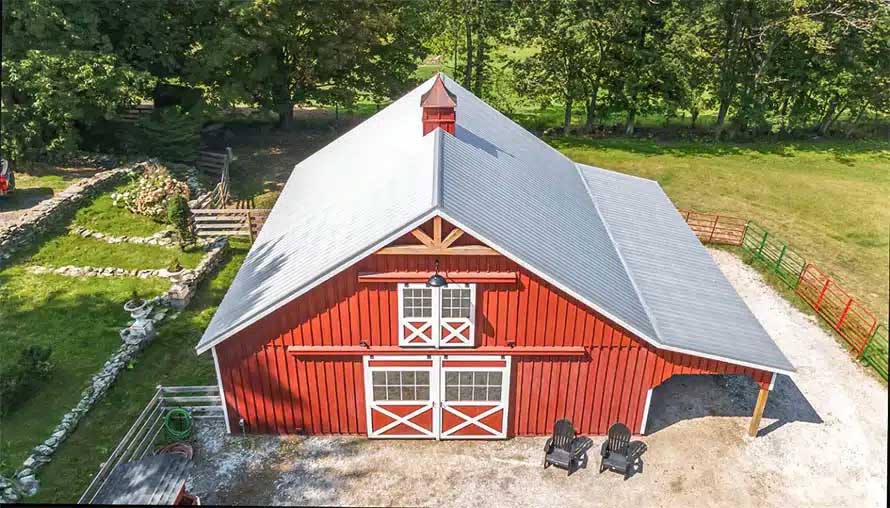
by Nikki Alvin-Smith for Horizon Structures
Why should you worry about the pitch of your horse barn roof? There is much more importance to roof pitch and roof materials and shapes than meets the eye.
Why should you worry about the pitch of your horse barn roof? The steepness or angle of the roof of any building certainly makes a difference to its overall presence, aesthetic appeal and the amount of interior space under its umbrella, but there is much more importance to roof pitch and roof materials and shapes than meets the eye.
The steepness of a roof is described in mathematical terms. Pitch is commonly referred to in the building trade as a ratio. The ratio describes the number of inch(es) rise per horizontal foot. It is also sometimes referred to as the angle in degrees its surface deviates from the horizontal.
Thus, a flat roof will be the only roof that has a zero pitch while the alpine style A-frame roof that reaches the ground is the other extreme in regard to roof pitch.
The steeper the roof the harder it will be to install and to replace. The use of manlifts or special scaffolding is often necessary for safety during roof installation and repair.
There are many other pros and cons of different pitch ratios, and when it comes to the construction process extensive rules and regulations are involved that govern the safety of the structure. We’ve all seen photos of roof collapses during snowstorms, or high winds lifting roofs off buildings entirely. Generally, these incidents occur as a result of faulty design where ordinances were not followed and the downward force of the weight of ice and snow on the roof overwhelms the roof’s supporting structure.
In extreme circumstances even the best constructed and well-designed roof can fail, particularly if high winds move snow across the roof and it accumulates unevenly on the surface.
A roof needs to be able to withstand sustained high winds. Various ratings apply to shingle types and designs, and sheathing of the roof needs to be properly affixed to the main substructure of the building to avoid uplift. The use of collar ties in the upper third of the roof space can help the roof resists uplift. While rafter ties (horizontal framing members) installed on the lower third of the roof space help prevent an outward force on exterior walls. The appropriately rated and sized metal plates, hurricane ties, rafter ties, bolts and nails as well as their proper placement is essential to the permanence of the roof.
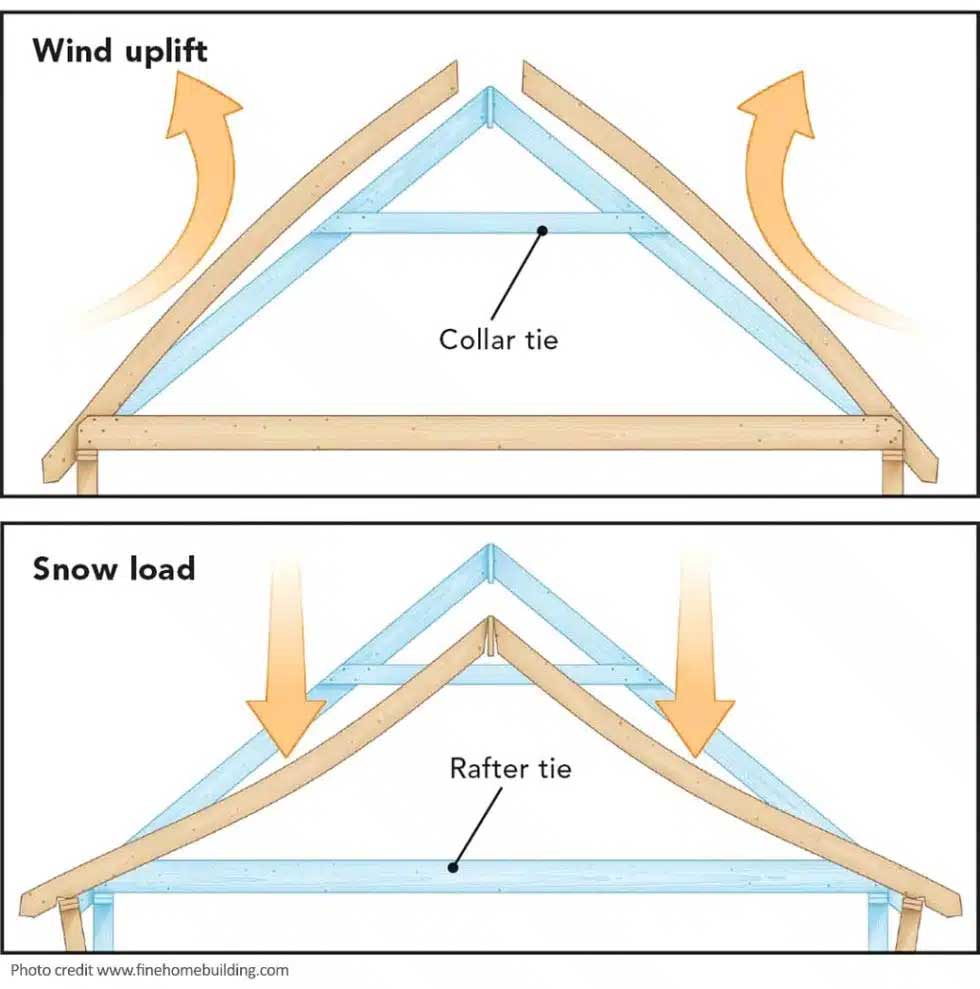
Open sided buildings will always be vulnerable to wind uplift, but all buildings are subject to this dynamic suction process that literally lifts the roof off the structure. It occurs where winds blowing parallel to the roof cause air pressure above the roof to be lower than that below it. A veritable Wizard of Oz situation!
Many rural communities do not require any type of building permit for agricultural use structures. This makes it easy for construction companies to overlook the mathematics of roof snow loads in the region, or to provide roof installation methods that offer hurricane protection.
How Well Does the Roof Do Its Job?
Beyond the obvious job the roof does of providing protection for the interior of the building from snow and rain, its ability to shed snow load and rain effectively rather than allow standing water or snow to gather on its surface causing water leaks is monumentally affected by its shape, its pitch, and the materials from which it is constructed. A metal roof will shed both snow and rain better than a shingle roof and thus usually requires less pitch to accommodate the snow and rain load requirements.
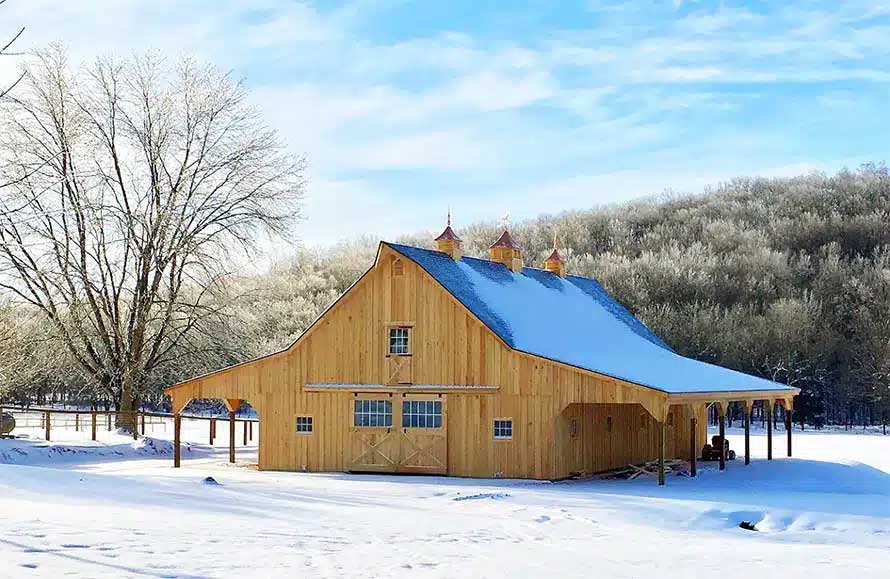
The roof also needs to offer good ventilation for the interior of the structure. This is usually accomplished by installing roof ridge vents or gable end soffits and/or cupolas. Mechanical aid in the form of fans is sometimes installed to improve airflow within the building.
Insulation Makes a Difference
The underside of the sheathing of the roof is also something to consider. The addition of a layer of insulation beneath the roof sheathing will not only mitigate the noise of heavy rain or hail on a tin roof insulation, but it will also prevent condensation from a metal roof.
Aside from the moist damp environment that condensation can create, the constant dripping of water onto hay supplies can cause mold to form and render the forage risky to feed, while water that drips from the roof into stalls or aisleways can make rubber mats slippery and unsafe.
An insulated roof will also help prevent ice dams forming on the roof during the daily freeze/thaw cycle in snowy regions.
Metal roof barns that are located in hot climates are subject to heat radiating to the interior of the building. A roof should deflect the heat of the sun during extreme high temperatures and color as well as materials used to clad both the surface and underside of the roof should be carefully considered.
The addition of plastic panels in the roof or skylights can add light to the interior of the structure and provide benefits of warmth in colder climates as well as diminish energy costs for lighting and heating the barn.
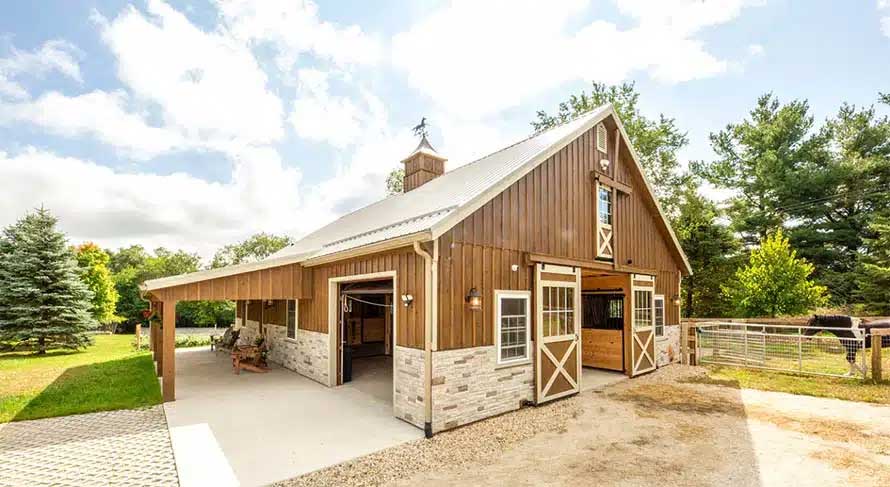
The use of drainpipes and a guttering system greatly enhances the functionality of a roof in regard to its ability to shed water and move it away from the foundation of the building.
How Strong Is the Roof?
The size and strength of the substructure that supports the roof, as well as the method by which it is attached to the framed members of the sidewalls is also an important consideration. Between suction from wind uplift, aspiration of water off the roof to the underside of the eaves and standing snow/ice or water load the rafter/truss system necessarily requires a well-engineered design.
Different roof styles offer various pluses and minuses when it comes to their ability to withstand wind (the hip roof is considered superior to other styles in this regard), and to shed water and snow.
The wider the span of the roof the heavier duty the support system, whether trusses or rafter design, will need to be. This is why steel trusses are often used in large agricultural buildings such as indoor arenas versus wood materials. Trusses are stronger than rafter construction and they transfer the weight or load of the roof to the outer walls of the structure allowing the interior to be free of posts/pillar or interior wall support.
Should You Choose a Shingle and Metal Roof?
There are many other factors to think about when choosing your roof.
The fire rating of a roof can be an element in how much insurance you’ll pay. Unrated roof coverings offer the worst fire rating and Class A, B or C, with A being the highest rating, can save you money as well as give you better peace of mind.
Shingle roofs may be made of asphalt or fiberglass, with asphalt having a worse fire rating but a better choice for durability in cold climates and for its ability to withstand high winds. But shingles can crack, corrode and shrink over time and are not as durable as a metal roof.
Application of a layer of ice and water shield over the sheathing layer of a shingle roof underneath the felt or tar paper can notably extend its durability. This is especially useful in snowy regions where ice dams may result from blocked gutters and spouts, lack of roof insulation or lack of airflow under the soffits of the roof.
A metal roof can offer good fire resistance and energy efficiency and can last up to 50 years. Additionally, a metal roof can better withstand high wind than a shingle roof and will require less maintenance over its lifespan.

Metal roofs also vary significantly in quality and thickness. A thicker metal roof is not necessarily better than a thinner one, it all depends on the decimal thickness of the aluminum or steel being used and whether that number includes the paint layer or not, as well as what the tolerance of the steel is as defined by the manufacturer.
Metal roofs that are manufactured of poorer quality materials will chalk over time and become unsightly requiring repair. This is due to a poor method of paint application to the bare metal or the use of substandard quality paint.
Adverse elements to all roof materials include chemicals and pollutants in the atmosphere and of course water. These elements can break down the pigment in the paint causing it to fade.
Take Home Message
When you are considering a new barn build don’t be shy to ask questions about how these facets are managed in the design you choose.
While steeper roofs will better shed snow and ice than a low-profile roof, and metal roofs shed water better than fiberglass or asphalt shingle depending on the appropriate pitch, there are many construction factors to review that ensure you are comparing ‘apples to apples’ when obtaining your quotation for a new horse barn.
This article originally appeared on Horizon Structures and is published here with permission.
You can find more informative articles in our section on Tack & Farm.
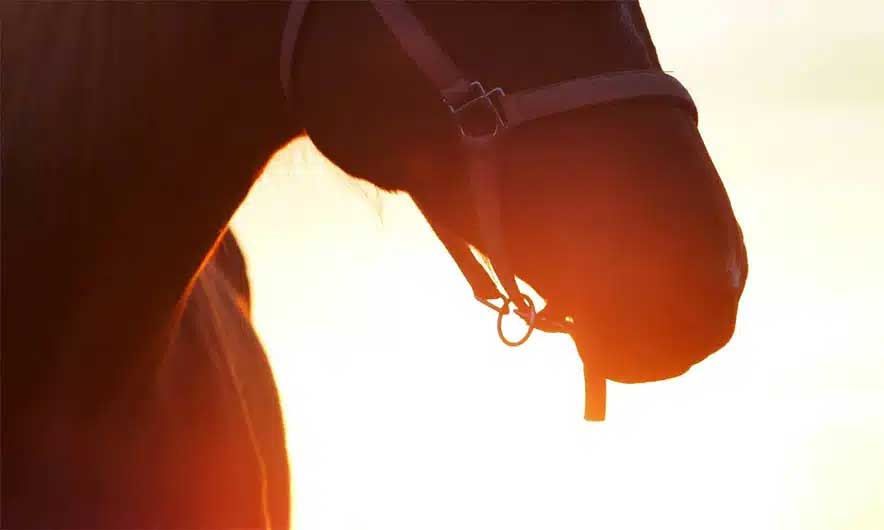
by Nikki Alvin-Smith for Horizon Structures
Brutally cold or extremely hot temperatures and inclement weather conditions can inflict great suffering on horses that are left to their own devices in an open pasture.
Brutally cold or extremely hot temperatures and inclement weather conditions can inflict great suffering on horses that are left to their own devices in an open pasture. However well hayed-up and warm watered the equine is kept in tempestuous winter storms and however hydrated and shaded a horse is managed in burning heatwaves, their well-being is dependent on more than these precautions to keep them in good health.
Horse caregivers are often quick to defend their horse care practices where a lack of understanding and education persist as to the actuality of how horses manage in the wild or how they suffer as a result of their inability to choose their own environment.
Consider the ever-present conflicts and conversations about whether a horse should be blanketed and if so at what temperature or humidity level, or the advertisements touting what shampoos can assuage discoloration of a pristine black equine coat or product can protect a gray horse from melanoma as good examples of issues related to horse care in certain types of weather.
There are many good reasons not to brave the weather when it comes to horse care, and these are just a few.
If you’ve ever lived in Wyoming or Montana and other regions where arctic air breezes in each year with the subtlety of the interest a mare in season shows in a stallion, then you’ve seen the results of frostbite on the stubby eared equines that showcase their exposure to Mother Nature’s wrath.
For those of us with experience in the world of horse breeding we know just how fast a foal or weanling can become dehydrated or chilled despite their otherwise apparent good health due to extremes of temperature and exposure to sun and rain. Elderly equine statesmen are similar to the youngstock in that their temperature regulation is not in full operation working to ideal capacity so also similarly to their junior counterparts they are at risk for health issues caused by severe weather (be it hot or cold).
A horse that is not in good health will also be more susceptible to disease and illness when subjected to extreme weather. Huge variances in the weather can also induce existing health problems to escalate or begin a cycle of harm to a horse that makes it at higher risk for similar health issues to occur in the future.
Horses that ‘go to the doctor’ aren’t given a written warning the way a human receives information, that the doxycycline they’ve been prescribed to treat Anaplasmosis or Lyme disease can cause them eye damage if they don’t protect their eyes from the glare of the blinding sun that reflects off snow or water. The Equus is painfully unaware (or will be) that liver damage may result from too much exposure to the sun’s rays when taking certain drugs. Indeed often, the horse caregivers themselves are blind to the side effects of medicines prescribed or over the counter remedies that can be purchased for treatment of equine maladies.
Is A Run-In Shed Enough?
The provision of a permanent form of shelter (not seasonal hedgerows or tree canopies) is always a good start to providing protection from the elements for horses at pasture.
While the horses have the opportunity to choose between being under cover of its roof or standing in the pasture the reality is the equine resident does not always make the smart decision. Like naughty children they sometimes do the complete opposite of what we expect them to do. Instead of seeking shade from the midday sun, they will stand next to the cooling effect of the water trough with their heads hanging low over the water surface catching sunburn on their white or pink noses. In the blasts of a Nor’easter they will stubbornly stand by the gate knee deep in mud rather than huddle up in the back of the run-in shed.
A run-in shed can provide a good temporary solution to providing some kind of shelter from the weather for horses that may be recently moved to a property without a barn or some form of enclosure suitable for their occupation.
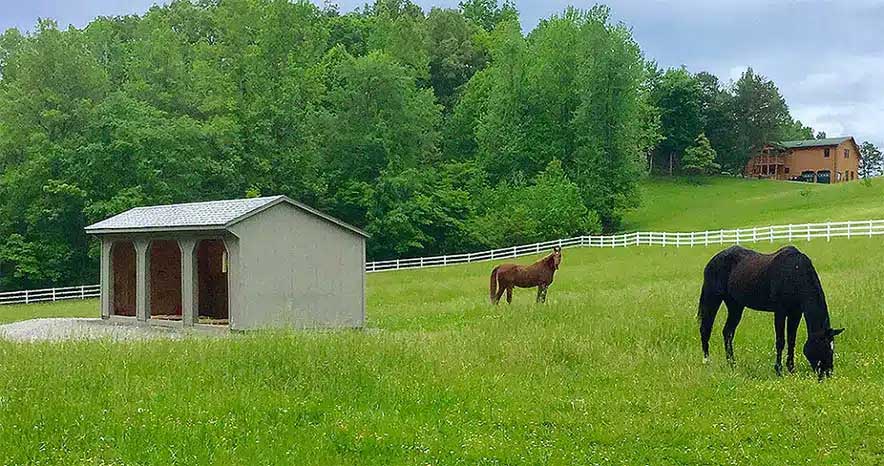
But sadly, no, sometimes the run-in shed is not enough to provide the shelter needed in extreme weather conditions. Its 3-sided protection cannot abate whipping winds that bring wind chills to minus double digits of -30 to -40 degrees Fahrenheit. While the horse’s long neck will help protect its lungs from the damage of the bitter cold air, the extremities of the horse are exposed and subject to frostbite.
Horses do not innately know that the sun’s rays are bad for them when they are taking certain medications or have a genetic make-up that makes them prone to health problems. A gray horse or an equine genetically at high risk for skin cancers will not know it needs to stay out of the sun to minimize its likelihood of developing the disease.
Ironically a gray horse has a more reflective coat to protect it from heat than a black horse, and a darker colored horse suffers more from flies and other insect attraction than a gray horse. Color of the coat, weight, condition, and breed of the horse, all affect the individual horse’s ability to weather the weather. Horses often simply don’t have the choice to make the right decision for their individual needs, even if they innately figure out the best solution to a problem they are experiencing such overheating or they are wet and cold.
The Immeasurable Pleasure of Owning a Horse Barn
There is an audible sigh of relief heard from most horse caregivers when their herd is safely shepherded into the warmth of well-bedded stalls during horrid weather or rescued from the incessant activities of biting flies and ensconced in cool, shady stables.
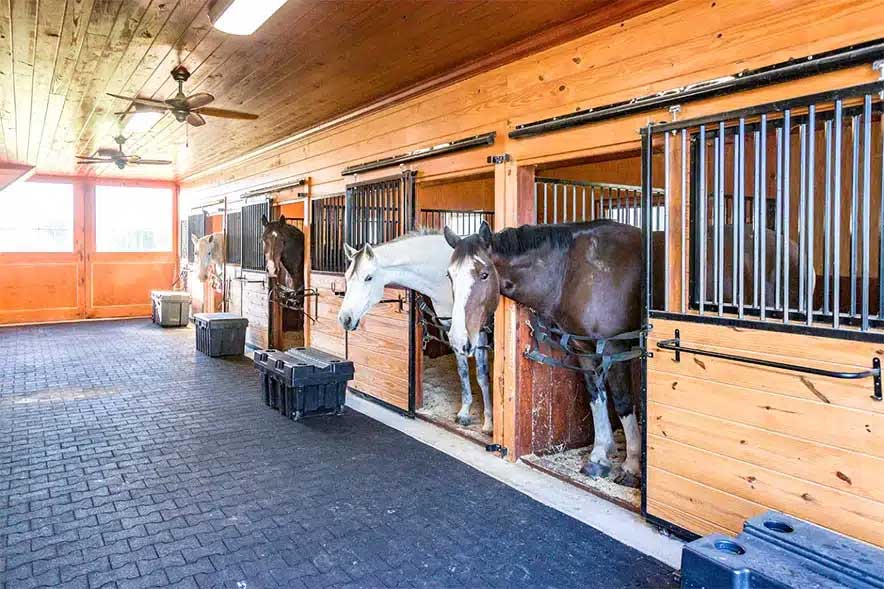
A barn offers the horse a respite from extremes of weather, but it also serves a valuable purpose as a hospital bed or an examination room.
The horse barn offers a retreat for the Equus suffering from too much herd interaction and can mitigate its ability to overindulge on sugary short green pastures of Fall and the rich spiking grass of Spring. In times of extreme human behavior, such as neighbors setting off celebratory fireworks, the barn can also become a much-appreciated refuge and safe harbor for the noise sensitive equine.
The benefits of being able to shelter from adverse weather in the barn is also important for the human contingent on the farm.
Styles and designs of barns come in all shapes and sizes. The array of options comes with a variety of price points, and the availability of modern-day modular barns makes the ownership of a horse barn something that can be undertaken in an almost ‘instant’ way.
The most inexpensive barn designs that can offer confinement of a horse is a shedrow design. The addition of an overhang can help protect the interior from driving winds and rain over Dutch doors, and shedrow designs are easy to add to if extra stalls are needed down the road. The more expensive high profile center aisle barn design is at the top of the price range with high end timber frame models being the crème de crème when it comes to horse barn style.

There are many options in-between these designs that offer pros and cons of each and where the property is sited, and its climate and environment should factor into the decision.
For example, a shedrow design may be perfectly suited to a temperate environment such as the mid-Atlantic seaboard, but its limitations will be felt if placed in the snowy regions of Maine or Montana where persistent plowing out to access each stall space during blizzard conditions will be needed and the lack of protection from bitter winter winds will be evident.
For large herds of horses, it is commonplace to provide a big indoor structure such as a cowshed or machine shed where the horses can be gathered together in during poor weather. Wherever animals gather together their bodies will produce a good source of heat, and livestock sheds and buildings can provide a reasonable solution as a safe harbor for a horse herd during severe weather.
Consider the interior of the building and its substructure when housing horses in large metal buildings, and also its passive or mechanical ventilation. Horses are not cows and are much more likely to roll next to a tin wall or kick out at a compatriot equine and errant hoof placement through a metal siding is a recipe for disaster.
In terms of fresh air, a horse’s respiratory system will benefit from good ventilation wherever it lives. Shutting out the wrath of winter may be necessary for short periods but overall a horse will do better health wise with access to plenty of fresh air and light.
An enclosed barn stall is an open plan dining/living room and bathroom for the horse, and yes, as such it does require more horsey housework. It also requires a capital investment. Nonetheless, owning one is a capital idea. You’ll never regret it. And don’t forget, what’s good for the outside of a horse is good for the inside of a human.
This article originally appeared on Horizon Structures and is published here with permission.
You can find more informative articles in our section on Tack & Farm.
- Five Western Saddle Q&As
- Horses and Vehicles – The Practicalities of Mixing Horsepower Housing
- Today on the Bench: Re-setting the Seam on a Saddle (4:15)
- Blanket and Fly Sheet Measuring 101
- Julie Goodnight: Talks About Saddle Fit with Darrell Nephew of Circle Y Saddles
- Dual Barns Mean Dual Customer Base
- How To Manage Horse Barn Needs After Catastrophe Strikes
- Equitopia - What to Expect in a Saddle Fit Evaluation (5:16)
- Barn Design and Management Tips For Competition Horses
- Difficult Horses. Difficult Boarders
































